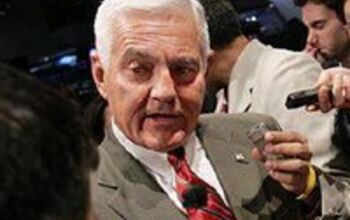General Motors Death Watch 238: No, No, Nadir
You knew this would happen. Whenever things go wrong or come to an end we can’t help but look back and try to figure out why. To look for that one pivotal event that changed the course of events forever. So what did it for GM? When did it happen? After careful analysis I pinpoint their demise to the 3.8L V6 (a.k.a the 231) of the 1970s.
First, the runners up and why they didn’t make the final cut. The Corvair certainly garnered a lot of bad press for being “Unsafe At Any Speed.” For all of its bad points, including the gas fired heater, it just wasn’t that bad of a car. Furthermore, it was a niche vehicle and never sold in enough numbers to really cause any permanent damage to the then-mighty GM. Remember, in the 1960s GM was responsible for selling over 50% of the vehicles in the US. Many look back at the Corvair as nothing more than an experiment that didn’t work.
Fast forward to the early 1970s. GM introduces the Vega, its response to the fuel efficient imports, just in time for the oil embargo of 1973. To say the Chevy Vega was ill-conceived is an understatement. First, the GM hierarchy dismissed the warnings of their engineers that an aluminum engine block needs cast iron liners. Then they outsourced cheap Japanese steel that turned to aluminum foil after just a few winters. It was clearly a losing situation for GM as they got bogged down spending millions sidelining cars to replace engines and recalling others to replace fenders.
So why didn’t the Vega make the final cut? Truth be told it just wasn’t the meat of the market for GM then. Furthermore, the public was just starting to accept little cars that ran on four cylinders and many didn’t believe a four cylinder could be durable enough to hold up in the long run anyway.
Which brings us to our winner: the 3.8-liter V6. Or the 231, as it was more commonly known back then (it was more common to refer to engine size in cubic inches not liters). It quietly appeared on the scene then gained wide spread use in 1978. That year saw a major redux across the A-body line: Oldsmobile Cutlass, Pontiac Grand Prix and the Buick Regal. These were General Motors’ bread and butter products and they were wildly successful. And it is here that GM makes its final, fatal collision; the corporate Titanic hitting the metaphorical iceberg.
GM sent these cars out of the factory with a multitude of quality glitches of which 231 engine issues were no small part. The oil pump was poorly designed, causing the oil pressure to sink dangerously low. By the time the consumer figured out something untoward was happening, the engine was apt to have blown a bearing or, worse, seized up. Game over. If your 231 engine didn’t throw a bearing, there were transmission “issues.” Cracked springs in the suspension. Rear wheel cylinders that fell off of their backing plates. All of this pushed many in the public towards their GM repair shop, and then, imports. The rest, as they say, is history.
Looking back, GM should have jumped in and cleaned up this multifarious mechanical disaster with honor and swiftness. At the time, they had enough cash to make all their customers whole. It would have been an extremely expensive PR disaster, but pretending there wasn’t a problem sealed their fate with hundreds of thousands of former loyalists.
GM tried to run from the warranty claims. Worse, they continued producing the 231 well into the 1980s. In the years that followed, it was mostly more of the same. GM sent out V8s with soft camshafts, torque steering X-cars and Fieros a quart low on oil. As the quality issues stacked up, GM’s market share deteriorated.
In the 1990s, they had one last chance. Cash rich from the SUV craze, GM could have re-invested the profits into their cars to make them mechanically-bulletproof world-beaters. Sadly, they squandered on brands and products and deals they didn’t need. And so here we sit in 2009, trying to bail them out, trying to figure out how to turnaround a submerged leviathan.
The astute reader will have noticed that I’ve left out the Chevrolet Monte Carlo, the other model built off the A-body and a major player in 1978. The Monte Carlo also had a 3.8-liter V6. But that engine was derived from a Chevrolet design: it had 229 cubic inches, not 231. Those two cubic inches helped make the 229 much more sprightly. And durable. If GM had used the 229 in the rest of their divisions . . .
Imagine that: two measly cubic inches could have changed the course of GM forever. Then again, I doubt it. When a company can’t recognize, admit and correct its mistakes, it’s a rudderless ship bound to hit something, eventually.
More by Charles Dagastino
Latest Car Reviews
Read moreLatest Product Reviews
Read moreRecent Comments
- SCE to AUX Some pretty big strikes:[list][*]Drivetrain - how can a straight-6 be thrashy? Shame on you, Mazda.[/*][*]Poor fuel economy.[/*][*]Tire noise.[/*][*]Poor user interface.[/*][*]That colored dash is a bit garish for me.[/*][*]High price.[/*][*]Indistinct look in the Mazda lineup. Their SUVs are Russian nesting dolls.[/*][*]Nothing compelling to lure a buyer away from the bigger brands.[/*][/list]I don't see this moving the needle for Mazda in the US market.
- Ash78 Dear unions, thank you for your service and for expressing interest in our automotive factories. Due to your many decades of pressuring employers to do better, the more adept companies have gotten your message and have implemented most of your demands preemptively in order to maintain a better employer-employee relationship than the manufacturing industry as a whole.We truly appreciate your feedback and interest, and all it has done to improve employer relations since the industrial revolution. We take your concerns seriously and will be glad to reach back out if our situation changes.We will keep your resume on file for three years, per company policy.Sincerely,Everyone
- Theflyersfan I'm having a tough time figuring out Mazda's recent lineup decisions. I've mentioned before how having the CX-5 and CX-50 makes no sense as it seems like they would steal each other's sales instead of conquest sales from other brands. And now here comes the CX-70 vs 90 decision. If Mazda wanted to position the 70 above the 90 with pricing, I think they should have gone the Audi Q7 vs Q8 route. The Q8 costs more, has one fewer row, and is smaller on the inside, but has the more aggressive styling and tries to position itself as the sportier alternative large CUV in their lineup. With Mazda, the 70 and 90 seem to be in the position, like the 5 vs 50, to steal each other's sales. There isn't anything compelling me to get a 70 if I get more for my money with a 90, except 100,000 miles down the road, I won't have a folded up third row seat rattling around loosely. Mazda should have brought over the CX-60 and position that where they wanted the 70. I understand it's a touch larger than the X3, Q5, and GLC CUVs, which is a sweet spot in that market. Make the CX-70 a sportier alternative 2-row instead of such a blatant cynical move of just ripping a seat out of the 90, calling it an all new model and price it in the same ballpark. I want Mazda to succeed and continue to be independent, but decisions like these make me wonder what their future plans are.
- Daniel J This thing is just too big and not packaged great being RWD. I'd prefer a FWD/AWD pre 2024 Santa Fe sized vehicle. A true CX-70.
- Ash78 Now that we're on the topic, I think Apple owes us all a ton of money for bringing out new phones every 1-2 years and devaluing the one I have! /sDepreciation has always been a part of car ownership, far more so now if you're getting into EVs. I think it's just the discrete nature of these depreciation events (ie, price cuts) that have everyone wringing their hands.I'm too price sensitive -- not necessarily to BUY an EV -- but for the fear of what a truly disruptive battery tech might do to them. Split the differene with a hybrid or PHEV and you've reduced your car's reliance on battery tech as the primary determinant of value.


































Comments
Join the conversation
Pete, My sister bought an '84 Sunbird (J body)in '89 for going off to school. It had 50,000 miles on it at the time. I think it went through 6 alternators in the next 5 years and 60,000 miles. It got to the point that she could replace the alternator faster than I could on that car. It would also blow head gaskets if you probed it's top speed which was well north of 90mph. My twin sister then inherited it. It actually became more reliable with her than my older sister. I seem to only remember doing routine maintenance on it. Once it got away from my big sis and into my other sister's hands, it actually was a decent car if you kept it within it's limits. She then traded up to a '99 Maxima, and then later on a BMW. The 'Turd died an untimely death at the hands of a young driver. not long after we sold it. Which was good, as I don't think the 1.8 would have lasted too much longer, the cam bearings (or lack of) were shot and the bottom end was getting noisy.